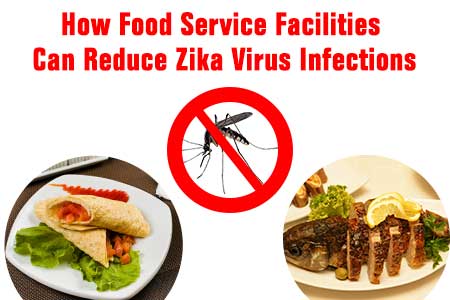Usually food safety is related to HACCPs for suppliers and careful handling and preparation by the operators.  However, that’s not all. Distributors act as essential intermediaries between manufacturers and foodservice operators, and the safety and quality measures taken by successful distribution centers are vitally important. The U.S. Department of Agriculture (USDA), and the U.S. Food and Drug Administration (FDA) interact most often with the foodservice supply chain.
However, that’s not all. Distributors act as essential intermediaries between manufacturers and foodservice operators, and the safety and quality measures taken by successful distribution centers are vitally important. The U.S. Department of Agriculture (USDA), and the U.S. Food and Drug Administration (FDA) interact most often with the foodservice supply chain.
An important aspect of food safety is maintaining the Cold Supply Chain. The term ‘cold chain’ is used to for the interdependent supply chain operations in the production, distribution, storage and retailing of chilled and frozen foods. The U.S. distribution chain includes more than 15,000 companies operating thousands of warehouses and fleets of trucks. Foodservice distributors must take care of food safety by protecting food from accidental and intentional contamination.
Here are some best practices and guidelines for ensuring food safety and maintaining the cold supply chain during distribution. The major areas of concern for food distributors start with the cold supply chain and maintaining appropriate temperature controls, but are not limited to just that. They also include proper sanitary conditions in facilities as well as trucks, avoiding cross-contamination and creating efficient logistics for shipping such as merge-in-transit.
Think of the Transportation of Food as an Extension of Storage
Greater food safety during distribution and transit requires food safety measures during warehousing to be extended to trucks. Just as in facilities, products should be loaded correctly to prevent cross-contamination between cured meats, raw product, seafood etc. and damage by heavier items at the bottom of a stack. Storage at correct temperatures (frozen, refrigerated or dry) in the truck is essential to maintain quality and safety. The food must maintain the correct temperatures throughout the multi-stop delivery process.
Maintain Correct Temperatures for Different Products
A distribution warehouse should have three temperature zones—ambient, cooler and frozen. The cooler area should be used to properly protect meat products, dairy and produce. The freezer should be at 0 °F or below. In trucks, foods with the same temperatures should be stored together, such as ambient products with other ambient products, products requiring the cooler with others and frozen with frozen to protect product integrity. For mixed loads, in which a trailer carries frozen, refrigerated and dry items, the cold chain should be maintained in sections separated by moveable bulkheads, with chutes blowing the appropriately tempered air into the chilled compartments.
Have Efficient Merge-In-Transit Procedures
For on-the-dock redistribution from one truck to another, called merge-in-transit or cross-docking, food must not sit for too long at the wrong temperature. If your company uses merge-in-transit, having refrigerated distribution docks and thorough inspection processes is essential. Product should be brought to the dock in a sequence that minimizes the amount of time spent on the dock during loading and unloading. Product temperatures for meat, poultry and eggs should not exceed 40 °F before loading. For perishable product especially, food safety procedures should be such that these products are moved immediately from the loading dock into the appropriate temperature zone in the warehouse or at the foodservice operation. Delivery trucks used for food distribution should be used solely for food products.
Time and Temperature Recording Systems in Transit and Warehouses
Certain foods, such as seafood, sensitive pre-cut produce and ready-to-eat products, can become unsafe if not held at appropriate temperatures. It’s important to have time and temperature recorders for shipment of these foods to help in monitoring them during transit. In-transit checks on temperature and refrigeration units, automatic time/temperature recording devices, log books documenting product condition upon arrival and during storage, trucks with onboard computers and GPS systems to track location of product at all times are just some of the measures.
Proper Inspections at Warehouses and Trucks
Trained personnel should conduct regular inspections of inbound products looking at the quality, condition (damage) and temperature aspects, especially perishable items. It’s essential to have an in-house quality assurance program which includes daily inspections of perishable products. To maintain a record of product condition and packaging, proper documentation is essential. The documentation should include a record of temperature readings and signs of spillage, damage or pests. Products which are close to their expiration date or damaged while at the facility should be logged, stored separately from other products for further inspection and returned to the supplier or dumped, if necessary.
Delivery Trucks shouldn’t be ignored- Maintain safety and cleanliness
Delivery vehicles should be of sturdy construction and should permit easy rear- and side-door locking and sealing. Trucks should be insulated and refrigerated so as to protect cargo against damage and walls and floors should be clean and free of cracks or holes to avoid entry of pests, vermin or dust, or affect temperature control. Truck design should allow cleaning, disinfection and temperature control, as well as inspections.
It’s essential to remove residues from previous cargo. For example, suppose the truck was previously used to deliver raw lettuce. To safely deliver frozen seafood now, it’s essential that every trace of lettuce and the bacteria and germs potentially carried in lettuce are cleaned out to avoid infecting the seafood. The cooling units should also be checked to make sure it’s in good repair and operational. Air chutes should be properly in place for effective air circulation. Trailers should be pre-cooled at least an hour before loading to chill insulation and air.
Overall Infrastructure that Enables Food Safety
To be efficient, food safety should be built into the overall design of both the facility and the trucks. This includes having sufficient capacity for dry and refrigerated food products (chilled and frozen), providing easy access to all areas for cleaning, adequate insulation and temperature-control capacity. For facilities, it is important to restrict unauthorized access through use of fences and locks and to have programs to prevent environmental contamination and infestation by insects or vermin.
Cold supply chain best practices and food safety are more important than ever. With the passing of the Food Safety Modernization Act (FSMA), the biggest regulatory overhaul in the history of the U.S. Food and Drug Administration (FDA), cold chain and food safety are getting more scrutiny than ever before. FSMA compliance has added new requirements for everyone in the food supply chain. Check out this webinar on Cold Chain Best Practices and the FSMA by expert speaker Joe Lynch to learn about the compliance requirements and how FSMA will impact food producers, distributors, and companies that transport food.




